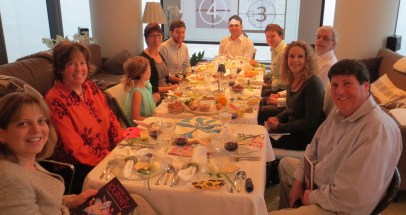If the Passover seder had an anthem, my vote would be for Dayenu– the jubilant, infectious melody responsible for resuscitating seders everywhere, year in and year out. Dayenu wakes us out of our seder stupors and inexplicably inspires all to join their voices in song: “Dai-dai-yenu, Dai-dai-yenu, Dai-dai-yenu, Dayenu, Dayenu!!!”
Dayenu—it would have been enough had God only delivered us from slavery, but God did more. Dayenu—it would have been enough had God only given us Shabbat, but God gave more. Dayenu—it would have been enough had God only bestowed upon us Torah, but God bestowed more.
When I reflect on Dayenu today, I struggle, because I see not enough emphasis on “enough” and too much emphasis on “more.” What does “Dayenu” mean in a world where bigger is (usually) better and more is (often) what we are looking for? How do we understand Dayenu in a society that prizes conspicuous consumption and fetishizes acquisition in every medium imaginable? When we are conditioned to believe that more stuff and more riches and more power will lead to a happier life, how do we even begin to set limits and embrace moderation? How do we adopt the idea of “Dayenu,” or “just enough” in a society that can never seem to get enough (accolades, money, power, status, etc.)?
And what does “enough” mean in a world where our children are asked to be everything to everyone–studious, sporty, intellectually curious, musical, artistic, socially conscious, tech savvy, and how about entrepreneurial? We want them to master a sport (or two or three), a language (or two or three), an instrument (or two or three) and a hobby (or two or three). But we also want them to be well mannered, concerned for others, deeply connected to their friends and community, and passionate (and if that passion can be parlayed into a career, even better). We cannot bear to waste the potential we see in them; we cannot bear to have them miss out on any opportunities availed to them. We desperately want the best for them and we want them to be their best.
But when and where in this scenario do we say “Dayenu”—he is doing enough or Dayenu, she has enough on her plate? When do we say “Dayenu,” this schedule is woefully too busy for a young adult and much too hectic for a child? At what point do we say, “Dayenu” too much of a good thing is not good? On the other hand, what would it mean to accept that “enough” is enough? To be smart enough, athletic enough, pretty enough, strong enough, quick enough, funny enough, popular enough, or good enough—what would it mean to say, that is perfect? What would it mean to teach our children, when you look in the mirror and see the person reflected back at you, that person is “enough”- to succeed in life, to excel in friendships, to create a solid foundation, to be a happy person. You are enough, period.
And what about ourselves? The expectations we have for ourselves and our families and our congregations often have very little grounding in reality. What is good enough for others is simply not good enough for us. “Enough” is not a standard bearer; “enough” is not worthy of praise. “Enough” is not gasp-inducing or eye popping. Enough is just adequate. It is merely satisfactory. It meets the criteria but it does not surpass. We don’t want enough; we want extraordinary. And yet, Dayenu…
There is nothing wrong with reaching for the stars. There is nothing wrong with pushing oneself to succeed and surpassing expectations. There is nothing wrong with perseverance and determination and high-octane drive. We need that passion to accomplish all we set out to do. We require that motivation to ignite the spark within our souls. But we meet a breaking point when the pursuit surpasses the prize, when we find ourselves on a relentless path towards the next best thing-at all costs.
When do we stop and say, Dayenu? This rung is high enough, this place is good enough and this pace is quick enough? When do we acknowledge ourselves and our families and our careers and say, we are enough—enough to appreciate and to accept and to cherish and to love? When do we say, enough is enough with always wanting more, with never being satisfied, with never giving ourselves the opportunity to savor the moment? When do we say, with true conviction, Dayenu?
We can look back to our Torah for a little help in the matter, and a little inspiration. When Moses called upon the Israelites to bring gifts towards the erecting of the Mishkan, the holy Tabernacle, they responded with unbridled enthusiasm. They brought and they brought and they brought some more. Ultimately, Moses had to stop the flow of gifts; the people had brought too much; “their efforts had been more than enough for all the work to be done.” (Exodus 36:7) In this case, God only wanted enough, no more, no less, just enough.
God got it right with the Mishkan. Passover gives us an opportunity to get it right with Dayenu. This Passover, may we all go from strength to strength to…Dayenu.
—
Rabbi Sara Y. Sapadin resides in New York City. She most recently served Temple Israel of the City of New York. Sara now volunteers as the CCAR RavBlog Member Volunteer. Interested in writing something for RavBlog? Learn more.

























